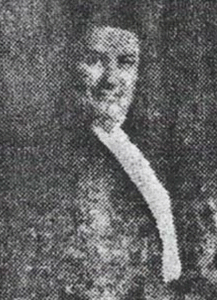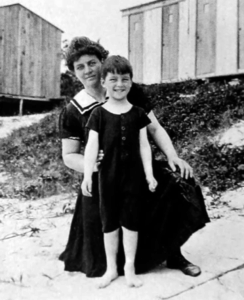May is a time when we pause to celebrate mothers—their devotion, strength, and the many forms their love can take. Over a century ago, when Titanic set sail on her ill-fated maiden voyage in April 1912, many mothers were among the passengers. Some traveled with children, while others journeyed toward them. No matter their class, age, or background, each of these women showed a mother’s strength before, during, and long after the voyage.
Among them were two remarkable women: Maria Louisa “Lulu” Thorne Drew and Margaretta “Daisy” Corning Spedden. Their stories remind us that motherhood isn’t defined by biology alone but also by the fierce love, protection, and care shown even in the most unimaginable circumstances.
A Devoted Aunt and Mother at Heart
 Maria Louisa “Lulu” Thorne Drew, 34, was a second-class passenger traveling with her husband, James, and her young nephew, Marshall Brines. While Lulu had no biological children of her own, she stepped into the role of mother when Marshall’s own mother passed away. Alongside her husband and Marshall’s father, William, she helped raise the boy, and he lovingly called her “Mother.”
Maria Louisa “Lulu” Thorne Drew, 34, was a second-class passenger traveling with her husband, James, and her young nephew, Marshall Brines. While Lulu had no biological children of her own, she stepped into the role of mother when Marshall’s own mother passed away. Alongside her husband and Marshall’s father, William, she helped raise the boy, and he lovingly called her “Mother.”
Lulu embraced this role fully, encouraging Marshall’s curiosity and sense of adventure. In 1911, Lulu and James took 8-year-old Marshall on a trip to England on board Titanic’s sister ship, Olympic. When it came time to return home to the United States, they booked passage on Titanic, drawn by the Ship’s size, luxury, and promise of safety.
On the night of April 14, 1912, Lulu tucked Marshall into bed and kissed him goodnight, never expecting it might be the last peaceful moment they’d share on board. She awoke later to a strange scraping noise and confusion on deck. Although initially reassured by others that nothing was wrong, Lulu heeded her husband, who urged her and Marshall to head to the lifeboats. He gently told them they “were to be taken to another ship while Titanic was being repaired.”
Lulu and Marshall climbed into Lifeboat 11. “My husband assured me that he would soon follow us,” she later recalled, but “he knew in his heart that I had kissed him for the last time.” Marshall, resting in Lulu’s lap, fell asleep as Titanic slipped beneath the waves.
In the aftermath, Lulu became Marshall’s legal guardian after William passed away not long after. She continued to guide and support Marshall as he grew into a talented artist and public school teacher. She lived a long life, passing away at age 92, having embraced the joys and responsibilities of motherhood in every way that mattered.
A Mother, A Memory, A Bear Named Polar
 Margaretta “Daisy” Corning Spedden was 39 years old and traveled first-class with her husband, Frederic, and their six-year-old son, Robert Douglas. A woman of wealth and privilege, Daisy lived a comfortable life—but nothing brought her more joy than being a mother.
Margaretta “Daisy” Corning Spedden was 39 years old and traveled first-class with her husband, Frederic, and their six-year-old son, Robert Douglas. A woman of wealth and privilege, Daisy lived a comfortable life—but nothing brought her more joy than being a mother.
Douglas was the center of Daisy’s world and rarely went anywhere without his beloved stuffed bear named Polar, a gift from his aunt. The bear was a high-end Steiff toy with movable limbs and changeable outfits, an ideal companion for an imaginative child on a great adventure.
In 1911, the Speddens embarked on an extended trip across Europe and North Africa, traveling through Algeria, Tunisia, Monaco, and France. Douglas brought Polar along for the journey, while Daisy documented their travels with photographs and diary entries. In April 1912, the family boarded Titanic in Cherbourg for their return to the United States, along with Daisy’s maid, Helen, and Douglas’s nanny, whom he affectionately nicknamed “Muddie Boons.”
Their four days at sea were peaceful and full of promise. A surviving photograph shows Douglas spinning a toy top on Titanic’s deck, a moment so iconic it was re-created in James Cameron’s Titanic film.
Everything changed late on April 14. Daisy described waking to “a sudden shock, a grinding noise and a stopping of the Ship’s engines.” She and Frederic gathered everyone, and all five made their way to Lifeboat 3. Since there were no other women and children nearby at that moment, Frederic was allowed to join them.
As they drifted in the cold night, Daisy tried to soothe her son by telling him they were “taking a trip to see the stars.” When morning came and Douglas saw the icebergs, he exclaimed, “Look at the beautiful North Pole with no Santa Claus on it!” Daisy later wrote, “… we all couldn’t refrain from smiling in spite of the tragedy of the situation.”
Safe on board Carpathia, Daisy extended her empathy to other survivors. She comforted grieving widows, made clothing from blankets for those in need, and confronted cruel remarks about third-class passengers: “We spend our time sitting on people who are cruel enough to say that no steerage should have been saved, as if they weren’t human beings!”
To help Douglas process what had happened, Daisy wrote and illustrated a book for him in 1913 titled Polar, The Titanic Bear, told from the perspective of his stuffed animal. It offered a creative way for both Daisy and Douglas to make sense of the life-changing event.
Tragically, just three years after Titanic’s sinking, Douglas was struck by a car and died at age nine. Daisy’s special book for Douglas wasn’t published until decades after her passing in 1950, but it now serves as a tender, special window into one family’s Titanic experience and a mother’s unwavering love.
Legacy of Love
The stories of Lulu Drew and Daisy Spedden offer two very different paths to motherhood, but both women showed extraordinary courage and love in the face of tragedy. Whether biological, adoptive, or chosen, motherhood is about showing up, holding steady in the storms, and offering comfort when it’s needed most.
As we honor mothers this May, we remember not only their sacrifices but also their strength. Just as Lulu and Daisy did, mothers shape lives and leave legacies of love that ripple through generations.
